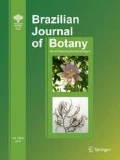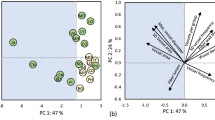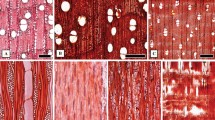Abstract
Iresine is an American genus that belongs to Amaranthaceae s.l. To understand its stem anatomy and correlation with the habit and habitat, a comparative study was carried out. We present the most extensive stem anatomical survey of Iresine to date. Our observations agree with wood descriptions for other Amaranthaceae having simple perforation plates, intervessel pits alternate and nucleated fibers. Few species showed distinctive growth rings. Rays are heterocellular, multiseriate with meristematic centers. The occurrence of rays with meristematic centers is not related to habit or habitat, but suggests that water and photosynthates movement is complex through the axial–radial system. Species studied have successive cambia in concentric bands or patches. Seven species have distinctive characters as for I. latifolia (M.Martens & Galeotti) Hook.f. with two or three pairs pith bundles, I. rzedowskii Zumaya, Flores Olv. & Borsch with a thick periderm and I. cassiniiformis S.Schauer with lignified pith. Not all quantitative wood features follow the trends expected with habit but significant differences exist (P > 0.05) for some as fiber length. The tree species has the widest vessel diameter (81 µm) and the longest fiber length (570 µm), and shrubs show the highest variation. Canonical correlation analysis allowed to identifying that mean annual temperature, longitude and annual rainfall have an impact in the wood of Iresine species, especially in vessel and fiber wall thickness, intervessel pit diameter and fiber length. Iresine wood appears to be more susceptible to changes of mean annual temperature and precipitation showing its plasticity.





Similar content being viewed by others
References
Agudelo CA (2009) Sistemática del complejo Iresine diffusa e Iresine herbstii (Amaranthaceae; Gomphrenoideae) de Colombia. Rev Asoc Col Cienc Biol 21:141–155
Agudelo CA, Valencia W, Torres GA, Mosquera LP, Castrillón M (2007) Anatomía de hoja y tallo de un morfotipo de Iresine diffusa H. y B. ex Willd. (Amaranthaceae) del volcán Galeras (Nariño), Colombia. Actual Biol 29:15–23
Aguilar-Rodríguez S, Terrazas T, López-Mata L (2006) Anatomical Wood variation of Buddleja cordata (Buddlejaceae) along its natural range in Mexico. Trees 20:253–261. https://doi.org/10.1007/s00468-005-0007-5
Angyalossy V, Pace MR, Evert RF, Marcati CR, Oskolski AA, Terrazas T, Kotina E, Lens F, Mazzoni-Viveiros SC, Angeles G, Machado SR, Crivellaro A, Rao KS, Junikka L, Nikolaeva N, Bass P (2016) IAWA List of microscopic bark features. IAWA J 37:517–615. https://doi.org/10.1163/22941932-20160151
Araújo GUC, Costa CG (2006) Cambial variant in the stem of Serjania corrugata (Sapindaceae). IAWA J 27:269–280. https://doi.org/10.1590/S0102-33062007000200021
Baas P (1973) The wood anatomical range in Ilex (Aquifoliaceae) and its ecological and phylogenetic significance. Blumea 21:193–258
Baird WV, Blackwell WH (1980) Secondary growth in the axis of Halogeton glomeratus (Bieb.) Meyer (Chenopodiaceae). Bot Gaz 141:269–276
Balfour ENA (1965) Anomalous secondary thickening in Chenopodiaceae, Nyctaginaceae and Amaranthaceae. Phytomorphology 15:111–122
Berlyn GP, Miksche JP (1976) Botanical microtechnique and cytochemistry. University Press, Ames, Iowa State
Bhambie S, Sharma A (1985) Ontogeny of cambium in Amaranthus caudatus L. and Achyranthes aspera L. Proc Pl Sci 95:295–301. https://doi.org/10.1007/BF03053239
Borch T, Flores-Olvera H, Zumaya Mendoza S, Müller K (2018) Pollen characters and DNA sequence data converge on a monophyletic genus Iresine (Amaranthaceae, Caryophyllales) and help to elucidate its species diversity. Taxon 67:944–976. https://doi.org/10.12705/675.7
Bramwell D (1976) The systematic position of the genus Bosea L. (Amaranthaceae). Bot Macaronés 2:19–25
Brown FBH (1922) The secondary xylem of Hawaiian trees. Occasional Papers of the Bernice Pauahi Bishop Museum of Polynesian ethnology and Natural History. Bishop Museum Press. Honololu, Hawaii
Campbell G, Rodrigues Rabelo G, Da Cunha M (2016) Ecological significance of wood anatomy of Alseis pickelii Pilg. & Schmale (Rubiaceae) in a tropical dry forest. Acta Bot Brasil 30:124–130. https://doi.org/10.1590/0102-33062015abb0267
Carlquist S (1975) Ecological strategies of xylem evolution. University of California Press, Berkeley
Carlquist S (1982) The use of ethylenediamine in softening hard plant structures for paraffin sectioning. Stain Technol 57:31–37. https://doi.org/10.3109/10520298209066729
Carlquist S (2001) Comparative wood anatomy. Systematic, ecological and evolutionary aspects of dicotyledon wood. Springer, Berlin
Carlquist S (2003) Wood and stem anatomy of woody Amaranthaceae s.s.: ecology, systematics and the problems of defining rays in dicotyledons. Bot J Linn Soc 143:1–19. https://doi.org/10.1046/j.1095-8339.2003.00197.x
Carlquist S (2010) Caryophyllales: a key group for understanding wood anatomy character states and their evolution. Bot J Linn Soc 164:342–393. https://doi.org/10.1111/j.1095-8339.2010.01095.x
Chalk L, Chattaway MM (1937) Identification of woods with included phloem. Trop Woods 50:1–31
Costea M, Demason D (2001) Stem morphology and anatomy in Amaranthus L. (Amaranthaceae) taxonomic significance. J Torrey Bot Soc 128:254–281. https://doi.org/10.2307/3088717
De Bary A (1884) Comparative wood anatomy of vegetative organs of phanerogams and ferns. Clarendon Press, Oxford
Duarte MR, Debur MC (2004) Characters of the leaf and stem morpho-anatomy of Alternanthera brasiliana (L.) O. Kuntze, Amaranthaceae. Rev Bras Ciênc Farm 40:85–92. https://doi.org/10.1590/S1516-93322004000100013
El-Ghamery AA, Sadek AM, Abd Elbar OH (2015) Root anatomy of some species of Amaranthus (Amaranthaceae) and formation of successive cambia. Ann Agri Sci 60:53–60. https://doi.org/10.1016/j.aoas.2015.03.001
ESRI (2010) ArcGIS Desktop: Release 10. Environmental Systems Research Institute, Redlands
Fahn A, Shchori Y (1967) The organization of the secondary conducting tissues in some species of Chenopodiaceae. Phytomorphology 17:147–154
Fahn A, Zimmermann MH (1982) Development of the successive cambia in Atriplex halimus (Chenopodiaceae). Bot Gaz 143:353–357
Figueroa ME, Giménez AM, Hernández P, Gaillard de Benítez C, Lorenz G (2011) Ecoanatomía de la madera de Allenrolfea vaginata (Griseb.) Kuntze (Chenopodiaceae) en ambientes salinos de Santiago del Estero. Ecol Austral 21:339–352
Flores-Olvera H, Zumaya S, Borsch T (2016) Two new species of Iresine (Amaranthaceae: Gomphrenoideae) from Mexico supported by morphological and molecular characters. Willdenowia 46:165–174. https://doi.org/10.3372/wi.46.46113
Fonti P, von Arx G, García-González I, Eilmann B, Saas-Klaassen U, Gärtner H, Eckstein D (2010) Studying global change through investigation of the plastic responses of xylem anatomy in tree rings. New Phytol 185:42–53. https://doi.org/10.1111/j.14698137.2009.03030.x
Grosso MA (2007) Crecimiento secundario inusual en raíz principal de Pfaffia gnaphalioides (L. Fil) Mart. (Amaranthaceae). Acta Bot Bras 21:21–26
Heklau H (1992) Beiträge zum anomalen sekundären Dickenwachstum im Spross einiger annueller Atri- und Chenopodium-Arten. Flora 186:23–26
Heklau H, von Wehrden H (2011) Wood anatomy reflects the distribution of Krascheninnikovia ceratoides (Chenopodiaceae). Flora 206:300–309
Heklau H, Gasson P, Schweingruber F, Bass P (2012) Wood anatomy of Chenopodiaceae (Amaranthaceae s.l.). IAWA J 33:205–232. https://doi.org/10.1163/22941932-90000090
Hijmans RJ, Cameron SE, Parra JL, Jones PG, Jarvis A (2005) Very high resolution interpolated climate surfaces for global land areas. Inter J Clim 25:1965–1978. https://doi.org/10.1002/joc.1276
IAWA Committee (1989) IAWA list of microscopic features for hardwood identification. IAWA Bull 10:219–332. https://doi.org/10.1002/fedr.19901011106
Jacques FMB, Franceschi DD (2007) Menispermaceae wood anatomy and cambial variants. IAWA J 28:139–172. https://doi.org/10.1163/22941932-90001631
Jáuregui D, Castro M, Ruíz-Zapata T, Lapp M (2014) Anatomy of the vegetative organs of two species of Atriplex (Chenopodiaceae), growing in Venezuela. Rev Biol Trop 62:1625–1636
Jiménez-Noriega MS, López-Mata L, Sánchez-González A, Vibrans H (2017) Anatomical variation of five plant species along an elevation gradient in Mexico City basin within the Trans-Mexican Volcanic Belt, Mexico. J Mt Sci 14:2182–2199. https://doi.org/10.1007/s11629-017-4442-8
Johansen DA (1940) Plant microtechnique. McGraw-Hill book Company, New York
Joshi AC (1931) Contribution to the anatomy of Chenopodiaceae and Amaranthaceae. I. Primary vascular system of Achyranthes aspera L., Cyathula prostrata Blume and Pupalia loppacea Juss. J Indian Bot Soc 10:265–292
Joshi AC (1937) Some salient points in the evolution of the secondary vascular cylinder of Amaranthaceae and Chenopodiaceae. Am J Bot 24:3–9
Kong L, Li F (2008) Anomalous secondary structures in stem and root two typical halophytes. Nord J Bot 26:364–367. https://doi.org/10.1111/j.1756-1051.2008.00164.x
Kribs DA (1935) Salient lines of structural specialization in the wood rays of dicotyledons. Bot Gaz 96:547–557
Lens F, Luteyn JL, Smets E, Jansen S (2004) Ecological trends in the wood anatomy of Vaccinioideae (Ericaceae s.l.) Flora 199:309–319. https://doi.org/10.1078/0367-2530-0058
Lev-Yadun S, Aloni R (1991) Polycentric vascular rays in Suaeda monoica and the control of ray initiation and spacing. Trees 5:22–29. https://doi.org/10.1007/BF00225331
Medina AA (2007) Evolución del hábito de Tidestromia Standl. (Amaranthaceae). Tesis Maestría. Universidad Nacional Autónoma de México, Ciudad de México
Metcalfe CR, Chalk L (1989) Anatomy of dicotyledons. Clarendon Press, Oxford
Myśkow E, Gola EM, Tulik M (2019) Continuity of procambium and anomalous cambium during formation of successive cambia in Celosia argentea. J Plant Growth Regul https://doi.org/10.1007/s00344-019-09948-3
Noshiro S, Baas P (2000) Latitudinal trends in wood anatomy within species and genera: case study in Cornus s.l. (Cornaceae). Am J Bot 87:1495–1506
Olson ME, Rosell JA (2013) Vessel diameter-stem diameter scaling across woody angiosperms and the ecological causes xylem vessel diameter variation. New Phytol 197:1204–1213. https://doi.org/10.1111/nph.12097
Olson ME, Anfodillo T, Rosell JA, Petit G, Crivellaro A, Isnard S, León-Gómez C, Alvarado-Cárdenas LO, Castorena M (2014) Universal hydraulics of the flowering plants: vessel diameter scales with stem length across angiosperm lineages, habits and climates. Ecol Lett 17:988–997. https://doi.org/10.1111/ele.12302
Pace M, Lohmann LG, Angyalossy V (2009) The rise and evolution of the cambial variant in Bignonieae (Bignoniaceae). Evol Dev 5:465–479. https://doi.org/10.1111/j.1525-142X.2009.00355.x
Pech-Polanco AC (2012) Descripción anatómica del tallo de ocho especies de Alternanthera Forssk. (Gomphrenoideae: Amaranthaceae). Tesis Licenciatura. Universidad Autónoma de Yucatán. Mérida, Yucatán
Rajput KS (2001) Secondary growth of the stem of Celosia argentea L. and Aerva sanguinolenta (L.) Blume (Amaranthaceae). Phyton 41:169–177
Rajput KS (2002) Stem anatomy of Amaranthaceae: Rayless nature of xylem. Flora 197:224–232. https://doi.org/10.1078/0367-2530-00033
Rajput KS, Marcati CR (2013) Stem anatomy and development of successive cambia in Hebanthe eriantha (Poir.) Pedersen: a Neotropical climbing species of the Amaranthaceae. Pl Syst Evol 299:1449–1459. https://doi.org/10.1007/s00606-013-0807-9
Rajput KS, Rao KS (1999) Structural and developmental studies on cambial variant in Pupalia lappacea (Amaranthaceae). Ann Bot Fenn 36:137–141
Rajput KS, Rao KS (2000) Secondary growth in the stem of some species Alternanthera and Achyranthes aspera (Amaranthaceae). IAWA J 21:417–424. https://doi.org/10.1163/22941932-90000257
Rajput KS, Patril VS, Kapadane KK (2010) Development of lateral meristem and pattern of secondary growth in stems and roots of Spinacia oleracea Linn (Amaranthaceae). Feddes Repert 121:209–218. https://doi.org/10.1002/fedr.201000009
Reyes RJ (2010) Ontogenia de la madera en tallos contrastantes de la tribu Cacteae. Universidad Nacional Autónoma de México, Ciudad de México, Tesis Maestría
Robert EMR, Schmitz N, Boeren I, Driessens T, Herremans K, De Mey J, Van de Casteele E, Beeckman H, Koedam N (2011) Successive cambia: a developmental oddity or an adaptive structure? PLoS ONE 6:e16558. https://doi.org/10.1371/journal.pone.0016558
Schmid W (1928) Das anomale sekundäre Dickenwaschstum der Amaranthaceae. Vierteljahrsschr. Naturf Ges Zürich 73, Beiblatt 15:542
Shelke RA, Ramoliya DG, Gondaliya AD, Rajput KS (2019) Development of successive cambia and structure of the secondary xylem in some members of the family Amaranthaceae. Plant Sci. Today 6:31–39. https://doi.org/10.14719/pst.2019.6.1.423
Terrazas T, Aguilar-Rodríguez S, López-Mata L (2008) Wood anatomy and its relation to plant size and latitude in Buddleja L. (Buddlejaceae). Interciencia 33:46–50
Townsend CC (1993) Amaranthaceae. In: Kubitzki K, Rohwer JG, Bittrich V (eds) The Families and Genera of Vascular Plants. Springer, Berlin
Vázquez-Sánchez M, Terrazas T (2011) Stem and wood allometric relationships in Cacteae (Cactaceae). Trees 25:755–767. https://doi.org/10.1007/s00468-011-0553-y
Wilkins AP, Papassotiriou S (1989) Wood anatomical variation of Acacia melanoxylon in relation to latitude. IAWA Bull ns 10:201–207
Wilson CL (1924) Medullary bundle in relation to primary vascular system in Chenopodiaceae and Amaranthaceae. Bot Gaz 78:175–199. https://doi.org/10.1086/333371
Zhang SY, Bass P, Zandee M (1992) Wood structure of the Rosaceae in relation to ecology, habit and phenology. IAWA J 13:307–349. https://doi.org/10.1163/22941932-90001284
Zumaya S (2008) Las especies mexicanas del género Iresine P. Tesis Maestría. Universidad Nacional Autónoma de México, Ciudad de México, México, Browne (Amaranthaceae)
Zumaya S, Flores-Olvera H, Borsch T (2013) Two new Mexican endemic species of Iresine (Amaranthaceae). Syst Bot 38:434–443. https://doi.org/10.1600/036364413X666633
Zumaya-Mendoza S, Terrazas T (2016) Vessel element and fiber length variation in successive cambia of Iresine latifolia (Amaranthaceae). Rev Mex Biodivers 87:1315–1320. https://doi.org/10.1016/j.rmb.2016.10.006
Acknowledgements
We thank CIBNOR, CICY, IBUG, MEXU and ZEA for giving access to herbarium material of Iresine wood. We are grateful to the Posgrado en Ciencias Biológicas (PCB) de la Universidad Nacional Autónoma de México and CONACYT (164721) for support during the graduate studies of SZ-M. We thank Hilda Flores Olvera and Guillermo Angeles for comments to an early version of this manuscript, Hermila Álvarez Medina, Álvaro Campos Villanueva, Pablo Carrillo Reyes, Arturo Castro, Reymundo Domínguez, Oscar Farrera Sarmiento, Jesús Guadalupe González Gallegos, Omar Ibarrarán Madrigal, David Juárez Gutiérrez, José Luis León de la Luz, Mauricio Mora-Jarvio, Arturo Mora-Olivo for help during field work, Enrique Ortiz for generating the environmental data and Julio Cesar Montero-Rojas for art work.
Author information
Authors and Affiliations
Contributions
SZ-M and TT designed the work and wrote the paper. SZ-M collected the material. SA-R and LY-E helped with the analyses, and all authors have read and approved and revised the manuscript.
Corresponding author
Additional information
Publisher's Note
Springer Nature remains neutral with regard to jurisdictional claims in published maps and institutional affiliations.
Electronic supplementary material
Below is the link to the electronic supplementary material.
Rights and permissions
About this article
Cite this article
Zumaya-Mendoza, S., Aguilar-Rodríguez, S., Yáñez-Espinosa, L. et al. Stem anatomy diversity in Iresine (Amaranthaceae s.l.): an ecological interpretation. Braz. J. Bot 42, 329–344 (2019). https://doi.org/10.1007/s40415-019-00530-5
Received:
Accepted:
Published:
Issue Date:
DOI: https://doi.org/10.1007/s40415-019-00530-5




